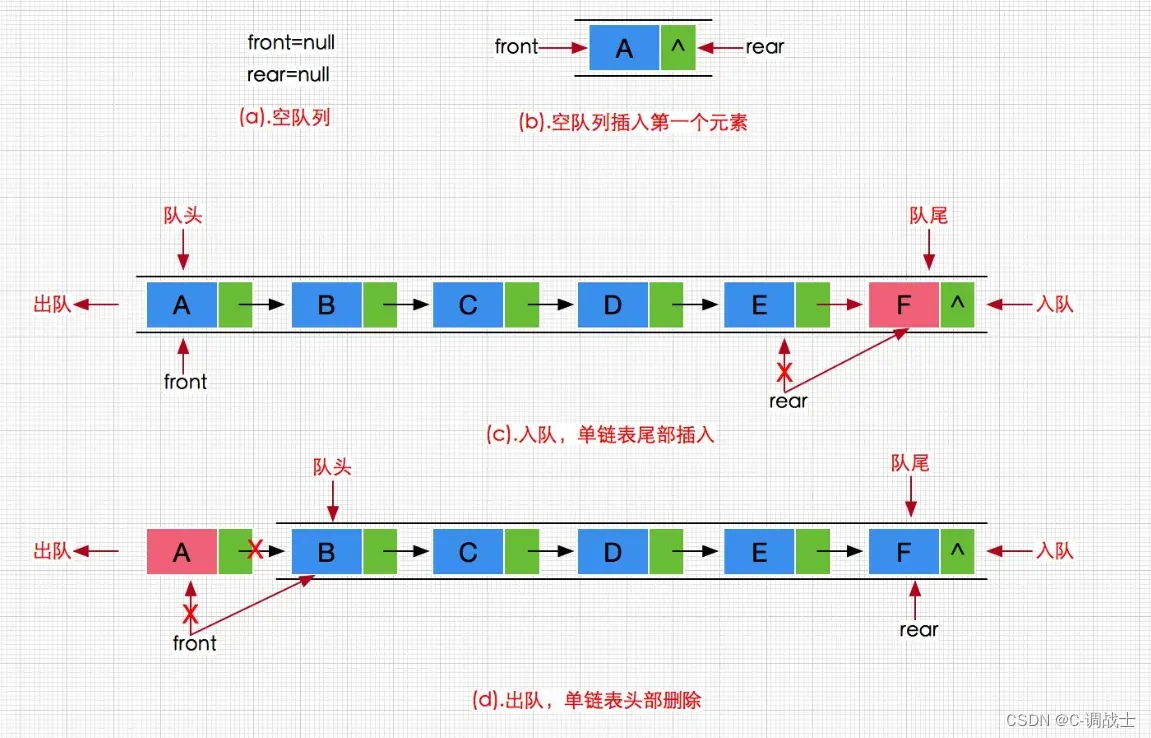
文章目录
- 🐸一、队列的概念及结构
- 🍄1、队列的概念定义
- 🍄2、动图演示
- 🐸二、队列的实现
- 🐸三、链表结构队列详解
- 🍎创建队列的结构
- ⭕接口1:定义结构体(QNode、Queue)
- ⭕接口2:初始化(QueueInit)
- ⭕接口3:销毁(QueueDestroy)
- ⭕接口4:入队列(QueuePush)
- ⭕接口5:出队列(QueuePop)
- ⭕接口6:取队头数据(QueueFront)
- ⭕接口7:取队尾数据(QueueBack)
- ⭕接口8:获取队列大小(QueueSize)
- ⭕接口9:判空(QueueEmpty)
- 🐸四、完整代码
- 🥝Queue.h
- 🥝Queue.c
- 🥝Test.c

🐸一、队列的概念及结构
🍄1、队列的概念定义
队列:只允许在一端进行插入数据操作,在另一端进行删除数据操作的特殊线性表,队列具有先进先出FIFO(First In First Out) 入队列:进行插入操作的一端称为队尾 出队列:进行删除操作的一端称为队头
- 入队列:进行插入操作的一端称为队尾
- 出队列:进行删除操作的一端称为队头
🍄2、动图演示


🌰可以想象成排队去食堂打饭,前面先打完饭的就从队头先走了,后来的就需要在后面队尾继续排队
🐸二、队列的实现
队列也可以数组和链表的结构实现,使用链表的结构实现更优一些,因为如果使用数组的结构,出队列在数组头上出数据,效率会比较低。
🐸三、链表结构队列详解

🍎创建队列的结构
🥰这里先创建三个文件:
1️⃣:Queue.h文件,用于函数的声明
2️⃣:Queue.c文件,用于函数的定义
3️⃣:Test.c文件,用于测试函数
建立三个文件的目的: 将队列作为一个项目来进行编写,方便我们的学习与观察。
⭕接口1:定义结构体(QNode、Queue)
🚩这里需要定义两个结构体:QNode、Queue,分别表示:队列链表每个节点结构和整个队列链表结构
🥰请看代码与注释👇
//自定义类型
typedef int QDataType;
//队列链表每个节点结构
typedef struct QueueNode
{
struct QueueNode* next;
QDataType data;
}QNode;
//整个队列链表结构
typedef struct Queue
{
QNode* phead;
QNode* ptail;
int size;
}Queue;
⭕接口2:初始化(QueueInit)
🥰请看代码与注释👇
//初始化
void QueueInit(Queue* pq)
{
//断言传入指针不为NULL
assert(pq);
pq->phead = NULL;
pq->ptail = NULL;
pq->size = 0;
}
⭕接口3:销毁(QueueDestroy)
🥰请看代码与注释👇
//销毁
void QueueDestroy(Queue* pq)
{
//断言传入指针不为NULL
assert(pq);
QNode* cur = pq->phead;
while (cur)
{
QNode* next = cur->next;
free(cur); //释放
cur = next;
}
pq->phead = pq->ptail = NULL;
pq->size = 0;
}
⭕接口4:入队列(QueuePush)
🥰请看代码与注释👇
//入队列
void QueuePush(Queue* pq, QDataType x)
{
assert(pq);
QNode* newnode = (QNode*)malloc(sizeof(QNode));
if (newnode == NULL)
{
perror("malloc fail\n");
return;
}
newnode->data = x;
newnode->next = NULL;
if (pq->ptail == NULL) //如果没有节点(空队列)
{
assert(pq->phead == NULL);
pq->phead = pq->ptail = newnode;
}
else //非空队列
{
pq->ptail->next = newnode;
pq->ptail = newnode;
}
pq->size++;
}
⭕接口5:出队列(QueuePop)
🥰请看代码与注释👇
//出队列
void QueuePop(Queue* pq)
{
assert(pq);
assert(!QueueEmpty(pq));
//1、一个节点
if (pq->phead->next == NULL)
{
free(pq->phead);
pq->phead = pq->ptail = NULL;
}
//2、多个节点
else
{
//头删
QNode* next = pq->phead->next;
free(pq->phead);
pq->phead = next;
}
pq->size--;
}
⭕接口6:取队头数据(QueueFront)
🥰请看代码与注释👇
//获取队头数据
QDataType QueueFront(Queue* pq)
{
assert(pq);
assert(!QueueEmpty(pq));
return pq->phead->data;
}
⭕接口7:取队尾数据(QueueBack)
🥰请看代码与注释👇
//获取队尾数据
QDataType QueueBack(Queue* pq)
{
assert(pq);
assert(!QueueEmpty(pq));
return pq->ptail->data;
}
⭕接口8:获取队列大小(QueueSize)
🥰请看代码与注释👇
//获取队列大小
int QueueSize(Queue* pq)
{
assert(pq);
assert(!QueueEmpty(pq));
return pq->size;
}
⭕接口9:判空(QueueEmpty)
🥰请看代码与注释👇
//判空
bool QueueEmpty(Queue* pq)
{
assert(pq);
//return pq->phead == NULL && pq->ptail == NULL;
return pq->size == 0;
}
🐸四、完整代码
🥝Queue.h
#pragma once
#include<stdio.h>
#include<stdlib.h>
#include<assert.h>
#include<stdbool.h>
typedef int QDataType;
//队列链表每个节点
typedef struct QueueNode
{
struct QueueNode* next;
QDataType data;
}QNode;
//整个队列链表
typedef struct Queue
{
QNode* phead;
QNode* ptail;
int size;
}Queue;
//初始化
void QueueInit(Queue* pq);
//销毁
void QueueDestroy(Queue* pq);
//入队列
void QueuePush(Queue* pq, QDataType x);
//出队列
void QueuePop(Queue* pq);
//获取队头数据
QDataType QueueFront(Queue* pq);
//获取队尾数据
QDataType QueueBack(Queue* pq);
//获取队列大小
int QueueSize(Queue* pq);
//判空
bool QueueEmpty(Queue* pq);
🥝Queue.c
#include"Queue.h"
//初始化
void QueueInit(Queue* pq)
{
assert(pq);
pq->phead = NULL;
pq->ptail = NULL;
pq->size = 0;
}
//销毁
void QueueDestroy(Queue* pq)
{
assert(pq);
QNode* cur = pq->phead;
while (cur)
{
QNode* next = cur->next;
free(cur);
cur = next;
}
pq->phead = pq->ptail = NULL;
pq->size = 0;
}
//入队列
void QueuePush(Queue* pq, QDataType x)
{
assert(pq);
QNode* newnode = (QNode*)malloc(sizeof(QNode));
if (newnode == NULL)
{
perror("malloc fail\n");
return;
}
newnode->data = x;
newnode->next = NULL;
if (pq->ptail == NULL)
{
assert(pq->phead == NULL);
pq->phead = pq->ptail = newnode;
}
else
{
pq->ptail->next = newnode;
pq->ptail = newnode;
}
pq->size++;
}
//出队列
void QueuePop(Queue* pq)
{
assert(pq);
assert(!QueueEmpty(pq));
//1、一个节点
if (pq->phead->next == NULL)
{
free(pq->phead);
pq->phead = pq->ptail = NULL;
}
//2、多个节点
else
{
//头删
QNode* next = pq->phead->next;
free(pq->phead);
pq->phead = next;
}
pq->size--;
}
//获取队头数据
QDataType QueueFront(Queue* pq)
{
assert(pq);
assert(!QueueEmpty(pq));
return pq->phead->data;
}
//获取队尾数据
QDataType QueueBack(Queue* pq)
{
assert(pq);
assert(!QueueEmpty(pq));
return pq->ptail->data;
}
//获取队列大小
int QueueSize(Queue* pq)
{
assert(pq);
assert(!QueueEmpty(pq));
return pq->size;
}
//判空
bool QueueEmpty(Queue* pq)
{
assert(pq);
//return pq->phead == NULL && pq->ptail == NULL;
return pq->size == 0;
}
🥝Test.c
#include"Queue.h"
//入队列测试
void TestQueue1()
{
Queue q;
QueueInit(&q);
QueuePush(&q, 1);
QueuePush(&q, 2);
QueuePush(&q, 3);
QueuePush(&q, 4);
while (!QueueEmpty(&q))
{
printf("%d ", QueueFront(&q));
QueuePop(&q);
}
printf("\n");
QueueDestroy(&q);
}
//测试
void TestQueue2()
{
Queue q;
QueueInit(&q);
QueuePush(&q, 1);
QueuePush(&q, 2);
printf("Size:%d\n", QueueSize(&q));
while (!QueueEmpty(&q))
{
printf("%d ", QueueFront(&q));
QueuePop(&q);
}
printf("\n");
QueueDestroy(&q);
}
int main()
{
//TestQueue1();
//TestQueue2();
return 0;
}
🥰这期内容相对比较简单,希望烙铁们可以理解消化哦!
总结🥰
以上就是 【数据结构】队列—C语言版 的全部内容啦🥳🥳🥳🥳
本文章所在【数据结构与算法】专栏,感兴趣的烙铁可以订阅本专栏哦🥳🥳🥳
前途很远,也很暗,但是不要怕,不怕的人面前才有路。💕💕💕
小的会继续学习,继续努力带来更好的作品😊😊😊
创作写文不易,还多请各位大佬uu们多多支持哦🥰🥰🥰
文章出处登录后可见!
已经登录?立即刷新

